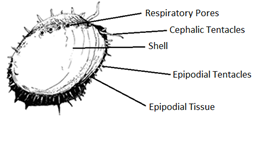It looks like something out of a science fiction movie: Arms peeling off and walking away on their own. Sometimes these lone arms even get eaten by other individuals.

In the summer and early fall of 2013, sea stars began dying on the west coast of North America from an unknown cause. The syndrome was first documented at Starfish Point on the Olympic Peninsula in Washington state (Science). Affected sea stars exhibited symptoms such as lesions, curling and twisting of arms, arm loss, and “melting”. While sea stars can usually grow back an arm if they lose it, these stars were too sick to do so. Based on the symptoms, it appears that the disease affects the soft tissue of sea stars (One Health Institute, Elise LaDouceur), leaving behind ghostly piles of ossicles, the bony parts of sea stars that make up their endoskeletons. Sea stars were and are still being affected along the west coast of North America from Alaska to Southern California (Pacific Rock Intertidal Monitoring), as well as on the east coast of North America (Science).
Recent research by Ben Miner, a biologist at Western Washington University, and his lab have identified four general locations where sea star populations were dramatically reduced from the most recent wasting syndrome event, including Vancouver, BC, the Seattle area, Monterey Bay, and Santa Barbara, with other areas along the west coast from Alaska to San Diego, CA impacted to a lesser extent (SSEC). It is currently unknown why populations in Washington and California have been heavily affected, while those in Oregon less so (Science). The first sighting of an affected sea star in Oregon was recently made last month (April 27th 2014) and affected stars such as sunflower stars, ochre stars, and giant pink stars have since been observed in Yaquina Bay, Oregon (Statesman Journal).
Kimber Chard, an avid diver and underwater photographer local to the Seattle area, says he has seen affected sea stars at most of the popular dive sites near Seattle, including Mukilteo, Three Tree, Redondo Beach, and Cove 2 in West Seattle, and has photographed some of the affected stars. Chard, who is a master SCUBA diver with over 630 dives logged to date, says that from what he’s seen underwater,”it’s evident that that’s [sea star wasting disease] what’s going on”. In popular dive sites like Cove 2, the number of sea stars has dramatically reduced (see video by videographer Laura James).
Multiple sea star species have been affected by sea star wasting disease. Washington state has upwards of 20 species of sea stars (Ben Miner, KQED-NPR), and many of these species are affected, including Solaster dawsoni (morning sun star), Evasterias troschelii (mottled star), Pisaster brevispinus (giant pink star), Pisaster ochraceus (ochre/purple star), and Pycnopodia helianthoides (sunflower star) that are experiencing high mortality (seastarwasting.org). Chard says that during his dives in the Seattle area he has seen a lot of healthy juvenile sea stars, seemingly unaffected by the wasting disease, providing some hope that sea star populations will be able to rebound in the area.
Although sea star wasting events have happened before, a mortality event of this magnitude and geographic scale has never before been seen (seastarwasting.org, Colleen Burge). Previous sea star wasting disease events have also been shorter in duration, lasting from about summer-November (Colleen Burge), while the current event is lasting well into winter and the next spring. Previous sea star wasting events include a major die off in southern California in 1983-1984 and again in 1997-1998 (seastarwasting.org). Previous events have typically been associated with warmer water temperatures during El Niño events. However, this event carried through to winter for the first time, when waters are relatively cool.

Both captive and wild sea stars have been affected. Mortality in parts of the
Seattle waterfront and in the captive collection at the Seattle Aquarium was 100% (SSEC). However, sea stars at some facilities in tanks where sea water is treated and filtered did not become sick, suggesting that the wasting disease may be the result of an infectious pathogen.
In the past when pathological studies have been done to determine the cause of the disease, it was typically attributed to a bacterium (vibrio), although a recent wasting event on the east coast of the United States has been attributed to a virus (seastarwasting.org). Other proposed hypotheses include novel pathogens introduced through ship ballast water, contaminated prey items (especially filter feeding animals that bioaccumulate toxins etc.), natural die offs, toxins, a virus, bacteria, manmade chemicals, ocean acidification, wastewater discharge or global warming. “It’s a huge huge mystery”, says Chard, who supposes that sea star wasting disease may be a result of a natural die off of sea stars due to unsustainable population numbers.
Colleen Burge, a posdoctoral researcher at the University of Washington, has been conducting exposure experiments on healthy naive sea stars to determine if the disease is transmissible (infectious) or non-infectious, an important step in understanding the disease. “The leg curling can occur pretty quickly post exposure, within the first few days, the lesions and arm loss occur between 14-22 days…progression is likely faster at greater temperatures”, says Burge on the progression of the disease in the laboratory. Based on the current evidence, “we believe this is an infectious disease”, says Burge.
Although some have suggested that the symptoms were a result of radiation from the Fukushima disaster, scientist have not found any evidence consistent with this hypothesis. In fact, while radiation from the disaster has probably reached the west coast of North America, it is not dangerous. As Kim Martini, a physical oceanographer at the Joint Institute for the Study of the Atmosphere and Ocean at the University of Washington in Seattle states in her blog post on the Fukushima disaster, “the additional radiation that was introduced by the Cesium-137 fallout is still well below the background radiation levels from naturally occurring radioisotopes.”, supporting the fact that sea star wasting disease is not a result of radiation.
Research groups and organizations involved in uncovering the cause for sea star wasting disease include Cornell (Harvell & Hewson), University of Rhode Island (Gomez), Brown (Wessel), Western Washington University (Miner), University of Washington (Friedman), UC Santa Cruz (Raimondi), Friday Harbor Labs, Wildlife Conservation Society, SeaDoc Society,Monterey Bay Aquarium, Vancouver Aquarium, USGS National Wildlife Health Center, NW ZooPath, the Seattle Aquarium, MARINe, and others (seastarwasting.org; SSEC). The research underway has already ruled out a number of potential causes, including fungi, protozoans, larger parasites, and some kinds of bacteria (Science). Marta Gomez-Chiarri, Professor at the University of Rhode Island, has found that in addition to sea stars, sea urchins and sea cucumbers can become sick as well.
Sea stars are not only iconic intertidal organisms, but also keystone predators that have a disproportionately large influence on the intertidal community. In his classic experiment in which he coined the term “keystone species”, Robert Paine of the University of Washington experimentally removed ochre stars (Pisaster ochraceus) from the rocky intertidal, and observed the effects of it’s removal. Once the predator was removed, mussels quickly took over and out competed other organisms, causing a dramatic shift in the community. Although sea stars have been established as a keystone species, it will be difficult to predict the effects of the syndrome on communities. Despite a large number of sea stars being affected, scientists are not concerned with a complete extinction of sea stars at this point, and are focusing their efforts on identifying the cause for the syndrome.
To document sea star wasting observations, please go here.
More information on sea star wasting disease:
KQED-NPR: What’s killing the starfish?
WNYC-BBC: What’s killing all the starfish?
Science for the People (starts at 28:00)
Science Magazine, News Feature: “Death of the Stars”
Sea stars of the Pacific Northwest
Sources:
Personal communication with Kimber Chard.
Personal communication with Colleen Burge.
Science Magazine, News Feature: “Death of the Stars”
2014 Salish Sea Ecosystem Conference Abstracts, Benjamin Miner & Lesanna Lahner.
The Statesman Journal: Sea star wasting disease arrives on the Oregon Coast.
One Health Institute. Video: Sea star wasting syndrome causing mass die-offs on the West coast. Elise LaDouceur. Resident, Anatomic Pathology. UC Davis School of Medicine.
Pacific Coast Rocky Intertidal Monitoring, Sea star wasting syndrome map.
KQED-NPR: What’s killing the starfish?
PBS. Video: Mysterious epidemic devastates starfish population off the Pacific Coast.















